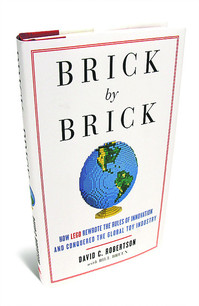Source of book image: online version of the WSJ review quoted and cited below.
(p. A15) Only 10 years ago, Lego was posting record losses; retailers were backlogged with unsold Lego toys; and it was unclear whether Lego would survive as an independent company. An internal review discovered that 94% of the sets in its product line were unprofitable. The turnaround story that followed is well told by Wharton professor David Robertson in “Brick by Brick.”
. . .
Upon coming to power, Mr. Knudstorp cut 30% of Lego’s product portfolio, including many of its newer offerings. To stave off financial doom, he also sold the company’s headquarters building and moved into simpler accommodations–and, more painfully, let go almost a third of the workforce.
But how to move beyond the rescue stage and toward growth? Based on input from top retailers and a large customer-research study, Lego executives concluded that even though young fans of buildable toys were a minority, there were enough of them to make a worthwhile market–and their parents were willing to pay premium prices. The company would now organize its innovation efforts around its potentially very profitable core audience.
Mr. Robertson, with the benefit of access to staff at Lego and partner companies, provides unusually detailed reporting of the processes that led to Lego’s current hits (and, inevitably, some misses). Among the hits is the Mindstorms NXT, the second generation of Lego’s robotics set, which hadn’t been updated or advertised since 2001. Mr. Robertson describes how Lego navigated between relying on sophisticated users to determine the product’s design and relying on its own expertise in the creation of building experiences.
For the full review, see:
DAVID A. PRICE. “BOOKSHELF; The House That Lego Built; Lego balked at licensing warlike ‘Star Wars’ toys. But then anthropological research convinced company executives that kids like to compete.” The Wall Street Journal (Tues., July 23, 2013): A15.
(Note: ellipsis added.)
(Note: the online version of the review has the date July 22, 2013.)
The book under review, is:
Robertson, David. Brick by Brick: How Lego Rewrote the Rules of Innovation and Conquered the Global Toy Industry. New York: Crown Business, 2013.

